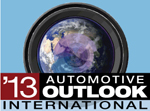The economic tribulations that befell the U.S. auto industry three years ago appear to have migrated to Europe, where consumer confidence suffers, austerity measures are triggering violence and industry downsizing seems inevitable.
Automotive parts suppliers everywhere in the world tend to be the tail wagged by the proverbial big dog, the auto makers. When times are tough, as they are in Europe, suppliers feel the pain most acutely.
 But some suppliers, such as Continental AG, manage to thrive in difficult times. Based in Hanover, Germany, Continental dates its corporate history to 1871, starting with balloon fabric and bicycle and carriage tires. The company developed the first grooved tires for automobiles, in 1904.
But some suppliers, such as Continental AG, manage to thrive in difficult times. Based in Hanover, Germany, Continental dates its corporate history to 1871, starting with balloon fabric and bicycle and carriage tires. The company developed the first grooved tires for automobiles, in 1904.
Much has changed, but the supplier’s core competency in tires remains a competitive advantage: A strong market for replacement tires can offset depressed sales of original-equipment parts, and vice versa.
Acquisitions in recent years of Motorola’s automotive electronics business and Siemens VDO, in addition to folding in ITT Automotive and the Teves brand of brakes in the 1990s, have positioned Continental as one of the largest, most-diverse suppliers in the world.
Chief Financial Officer and executive board member Wolfgang Schaefer sizes up the global industry and problems in the home market in this email interview.
WardsAuto: What is your outlook for the European market in 2013, and how will it affect your business performance?
Schaefer: We anticipate that the global market will continue to grow by between 1% and 3% in 2013. Europe is expected to slightly decline or stagnate, while the North American and Asian markets will continue to grow.
WardsAuto: Do you see the need to increase, decrease or maintain your global manufacturing capacity in the coming year? Which market segments are ripe for expansion and which face rationalization?
Schaefer: Our growth strategy is twofold: We expect further growth along the megatrends of the industry – safety, carbon-dioxide reduction and information technologies/network. And we are well prepared for these trends. In addition, we invest in regional growth, especially in the BRIC countries (Brazil, Russia, India, China). And this is valid not only for our automotive but for our tire and industry business within the ContiTech division, too.
WardsAuto: What sort of challenges remain in globalizing product platforms for components or vehicles?
Schaefer: First, emerging markets have gained much in importance. Second, our customers are adopting a platform approach that is resulting in volumes of up to a couple of million systems per year. Third, in the next 10 years, the former independent functions of powertrain, chassis and interior systems will be heavily integrated.
And as a consequence, automotive manufacturers will need systems suppliers that can support them in integrating those functionalities in the different areas. Continental is one of them. Another major industrial challenge is what we call “information fusion.” The same information has to be provided to all systems in the vehicle.
WardsAuto: Rank the top five emerging markets in order, as you see them. How has the list changed since 2009?
Schaefer: China, Brazil, Russia, the South East Pacific region (Thailand, for example), as well as India. Within the last three years, the order has not changed at all.
WardsAuto: Continental’s share price has skyrocketed 70% since the beginning of the year at a time when European vehicle sales have plummeted. Is it fair to say Continental has outperformed the European auto industry and other component suppliers? To what do you attribute the success?
Schaefer: In the last years, we have outperformed the markets where we are active, and we intend to do so in the next year.
The reason is our excellent product portfolio along the megatrends of the industry: The acquisitions of the past – including the automotive business of Motorola in 2006 and, above all, Siemens VDO in 2007 – are paying off now. And the outstanding performance of Continental is the result of the hard work of 170,000 employees of our company, some 10,000 of them working in the U.S.
WardsAuto: In the U.S., the Original Equipment Suppliers Assn. says its Automotive Supplier Sentiment index finds suppliers “significantly more pessimistic” now than in July. Do you agree with that assessment? Why or why not?
Schaefer: We do not agree with this statement as the NAFTA market (North America) is doing well. Production should be up by 8% this year and hence should be favorable for most of the NAFTA-based suppliers. We see further modest growth in the U.S. automotive industry for 2013 and 2014.
WardsAuto: Americans will elect a president next month. Do you think one of these presidential candidates, Mitt Romney or Barack Obama, will benefit the auto industry more than the other? If so, please explain.
Schaefer: Independent from the decision of the American people, we expect that the elected president will have an eye on the ongoing positive development of the auto industry.
WardsAuto: Continental opened a new electronics plant in China last year. When did production begin? Is this Continental’s 18th plant in China? Do you still need additional capacity there?
Schaefer: China is already the biggest car producer worldwide, and we believe that growth in China will remain in the high single-digit range in the long term and continue to be one of our most important growth markets. That is the reason why Continental has 18 plants in China and will employ about 20,000 people by the end of the year.
Our 2-wheel tire plant opened in Hefei in August. At the same time, we also expanded our electronics plant in Jiading, and we decided to construct a second plant in Wuhu as well for electronic products. And we will, of course, focus on further growth and take the steps needed.
WardsAuto: Continental’s closest direct rival is Robert Bosch. While you compete directly on several fronts, Bosch is exiting foundation brakes and is dissolving a battery joint venture while Continental remains strongly committed to foundation brakes and has entered into a battery joint venture. Can you explain the divergent strategies?
Schaefer: We strongly believe that it is competitive advantage to have competence in both the driving safety application and complete brake systems. Auto manufacturers like to have one contact for both topics to avoid problems with the interfaces.
One example is the integration of the parking brake functionality into the ESC (electronic stability control) unit. And the battery venture with (Korea’s) SK Innovation that makes us a newly full-range supplier for the electrification of the powertrain.
And despite all the challenges, Continental is convinced of the long-term marketability of electromobility. In 2025, we expect 11 million vehicles worldwide driven on electricity alone. Continental regards itself as one of the leading pioneers.
WardsAuto: Continental has a new plant dedicated to retreading tires for trucks and buses. Why not do the same with passenger-car tires?
Schaefer: The ContiLifeCycle plant you refer to combines retreading and rubber recycling. It is the first of its kind in the industry worldwide and an important step to a closed production cycle in tire manufacturing. For retreading, itself, there is no demand in the passenger-car tire segment. From the customers’ perspective, the potential price advantage does not justify certain limitations of the usage, which this technology implies.




